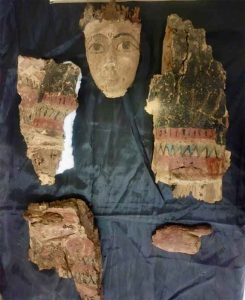A Byzantine and a late period collection of structure relics were uncovered in Meir Necropolis in the Assiut governorate, by an Egyptian archaeological mission.
The mission uncovered the remains on two levels with the upper level consisting of monks’ cells with a court as well as a number of chambers. The lower level is made up of a collection of burials.
According to Moustafa Waziry, the secretary-general of the Supreme Council of Antiquities “the discovery highlights the significance of Meir during the Old and Middle Kingdoms as well as the Late Period,” he said while referring to a Coptic text found on one of the walls of the structural remains.
The text is written in black ink and consists of eight lines of religious prayers. Above the text, you can see three clay shelves that may have been used to hold the monks’ equipment at the time manuscripts were written.
The burials include coffins and human skeletons that are deteriorating and are in poor condition along with funerary objects of an unidentified lady.
Adel Okasha, head of the Central Archaeological Department for Antiquities in Middle Egypt, said that the objects discovered include a decorated coffin in poor condition, a funerary mask and collar, clay pots, a group of blue and black faience beads, and two copper mirrors.
The Meir necropolis is located about 50 kilometers of northwest of Assiut, the Upper Egyptian city.




